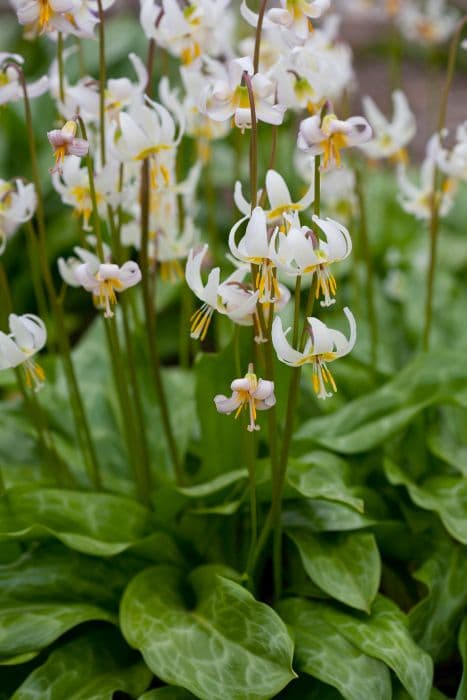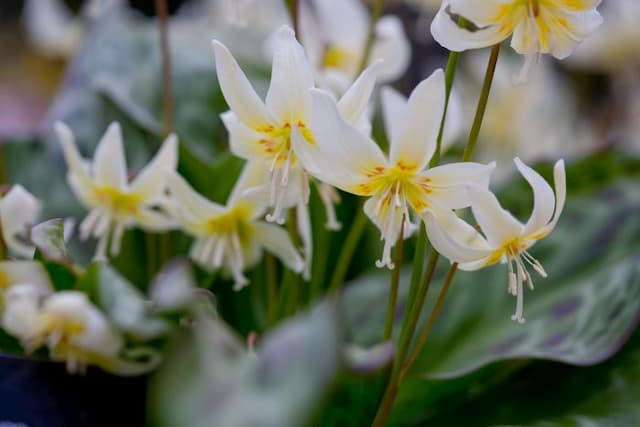Tulip Tulipa 'Negrita' (3)

ABOUT
Tulipa 'Negrita', commonly known as Tulip 'Negrita', is a striking plant with a distinctive and vibrant appearance. It features large, cup-shaped flowers that bloom with a deep, purplish-pink hue. The petals have a satin-like sheen and are often edged with a slight lighter tone, giving them a subtle glow and depth of color. The plant itself has a neat and upright habit, with a cluster of lance-shaped, green leaves at the base. The foliage can sometimes exhibit a waxy texture that adds to the visual interest of the plant. Each stalk typically supports a single blossoming flower, which becomes the focal point due to its bold and rich coloration. Tulip 'Negrita' is a favorite for its dramatic blooms that stand out in any garden setting, creating stunning visual displays when planted in groups.
About this plant
 Names
NamesFamily
Liliaceae
Synonyms
Negrita Tulip
Common names
Tulipa 'Negrita'
 Toxicity
ToxicityTo humans
The Tulip 'Negrita' is considered to have a low level of toxicity to humans. If ingested, the most common symptoms can include nausea, vomiting, and diarrhea. In severe cases, and particularly with the consumption of large quantities, symptoms could escalate to include dizziness, abdominal pain, or even an allergic reaction. It is advisable to avoid eating any part of the tulip plant.
To pets
The Tulip 'Negrita' is toxic to pets, especially cats and dogs. The bulb of the tulip contains the highest concentration of toxic substances, though all parts of the plant can be harmful if ingested. Symptoms of tulip poisoning in pets can include gastrointestinal irritation indicated by drooling, vomiting, and diarrhea. In more severe cases, ingestion can lead to depression of the central nervous system, increased heart rate, and difficulty breathing. Immediate veterinary attention is recommended if a pet has ingested any part of a tulip.
 Characteristics
CharacteristicsLife cycle
Perennials
Foliage type
Deciduous
Color of leaves
Green
Flower color
Purple
Height
1-2 feet (30-60 cm)
Spread
6 inches (15 cm)
Plant type
Bulb
Hardiness zones
3-8
Native area
Central Asia
Benefits
 General Benefits
General Benefits- Beautification: Adds vibrant purple color and aesthetic beauty to gardens and landscapes.
- Pollinator Attraction: Attracts bees and other pollinators, supporting local ecosystems.
- Seasonal Interest: Blooms in spring, providing seasonal interest after a long winter.
- Easy to Grow: Known for being low-maintenance and easy to cultivate for most gardeners.
- Variety: Part of the tulip family, it provides variety in terms of shape, size, and color amongst spring-blooming flowers.
- Cut Flowers: Suitable for cutting and can be used in floral arrangements.
 Medical Properties
Medical PropertiesThis plant is not used for medical purposes.
 Air-purifying Qualities
Air-purifying QualitiesThis plant is not specifically known for air purifying qualities.
 Other Uses
Other Uses- Tulip 'Negrita' petals can be used as a natural dye for fabrics, giving them a soft pink to plum color depending on the mordant used.
- The bulbs of Tulip 'Negrita' can be ground into a paste and used as a natural adhesive, suitable for light paper-based crafts.
- Dried and crushed Tulip 'Negrita' petals can be incorporated into homemade potpourris for a unique fragrance with floral notes.
- Pressed Tulip 'Negrita' flowers can be used in botanical art or to create delicate bookmarks or greeting cards.
- The strong stems of Tulip 'Negrita' can be used as natural supports for other plants in the garden, providing a subtle aesthetic touch.
- During blooming season, Tulip 'Negrita' flowers can be a source of food for bees and other pollinators, promoting biodiversity in gardens.
- The vibrant blooms of Tulip 'Negrita' can be used to create stunning floral water features by floating the heads in shallow bowls of water.
- The patterned petals of the Tulip 'Negrita' can be used in educational settings to teach patterns, symmetry, and color contrasts in nature.
- Empty Tulip 'Negrita' bulb casings can be repurposed to create small, biodegradable seed-starting pots for gardening.
- Tulip 'Negrita' petals can be used in craft projects, such as handmade paper making, adding texture and color to the paper.
Interesting Facts
 Feng Shui
Feng ShuiThe tulip is not used in Feng Shui practice.
 Zodiac Sign Compitability
Zodiac Sign CompitabilityThe tulip is not used in astrology practice.
 Plant Symbolism
Plant Symbolism- Love: Tulips, in general, are considered a symbol of perfect love, and their dramatic deep colors often represent strong and passionate feelings.
- Royalty: The rich purple hue of the 'Negrita' tulip is commonly associated with royalty and regal power, reflecting an air of nobility and luxury.
- Confidence: The bold color of this tulip symbolizes confidence and strength, inspiring people to express their feelings openly and with conviction.
- Transformation: Tulips are one of the first flowers to bloom in the spring, representing rebirth, new beginnings, and the transformation that comes with a new season.
 Water
WaterTulips, including 'Negrita', prefer moderate watering. During the growing season, provide about one inch of water weekly, either from rainfall or manually, which is approximately 0.6 gallons per square yard of soil. Water the bulbs deeply to encourage root growth. During the dormant season, after the foliage has died back, cease watering as these bulbs prefer drier conditions to rest. Overwatering can lead to bulb rot, so ensure the soil is well-draining.
 Light
LightFor optimal growth, Tulips require full sun conditions, which means they should receive at least 6 hours of direct sunlight each day. Planting 'Negrita' Tulips in a spot that gets morning sun is preferable, as the afternoon sun can sometimes be too intense. Ensure that the chosen location is not shaded or obscured by larger plants or structures.
 Temperature
TemperatureTulips like 'Negrita' are resilient in a range of temperatures but thrive in cooler conditions. They can tolerate winter temperatures down to about -40 degrees Fahrenheit, making them suitable for colder climates. The ideal temperature range for active growth is between 50 to 65 degrees Fahrenheit. During their dormant phase in summer, they can withstand higher temperatures as long as the bulbs are not waterlogged.
 Pruning
Pruning'Negrita' Tulips should be deadheaded after flowering by removing the spent blooms. Prune the foliage only after it has turned yellow and died back naturally, usually several weeks after blooming. This allows the plant to photosynthesize and store energy in the bulb for the next season. Pruning should be done annually once the flowering is complete.
 Cleaning
CleaningNot needed
 Soil
SoilTulips, including the 'Negrita' variety, thrive best in well-draining, fertile soil with a neutral to slightly acidic pH of 6.0 to 7.0. A mix of garden soil, compost, and sharp sand or perlite to promote drainage makes an excellent soil recipe for these bulbs. It is essential that the soil does not retain water, as tulips are prone to rot in wet conditions.
 Repotting
RepottingTulips, specifically the 'Negrita,' are perennial bulbs and do not need to be repotted annually. Instead, they should be planted in the ground or in outdoor containers and left to bloom yearly. After several years, if bulb performance declines, they can be lifted, divided, and replanted to rejuvenate growth.
 Humidity & Misting
Humidity & MistingTulips like the 'Negrita' are adaptable to a range of humidity levels and do not have specific humidity requirements. They grow well in the varying outdoor humidity conditions that occur naturally in their suitable hardiness zones.
 Suitable locations
Suitable locationsIndoor
Place 'Negrita' Tulip bulbs in pots with drainage, in cool, bright indirect light.
Outdoor
Plant 'Negrita' Tulips in fall, full sun, and well-draining soil.
Hardiness zone
3-8 USDA
 Life cycle
Life cycleThe Tulipa 'Negrita', commonly known as the Negrita Tulip, begins its life cycle when a bulb is planted in the fall before the first frost. The bulb undergoes a period of dormancy during the winter, requiring a cold period to stimulate the growth of the flower stem and leaves. In early to mid-spring, as temperatures rise, the tulip bulb breaks dormancy and a shoot emerges from the soil, soon followed by leaves and a bud. The bud develops into a vibrant purple flower, usually between April and May, depending on the climate. After the tulip blooms, the petals eventually wither and fall off as the plant enters the senescence phase, wherein the foliage turns yellow and dies back. The bulb remains underground, where it will rest until the next growing season, storing energy and completing the cycle.
 Propogation
PropogationPropogation time
Spring
Tulipa 'Negrita', commonly known as Triumph Tulip, is typically propagated by the division of its bulbs. The best time to do this is in the late summer or early fall when the foliage has died back and the bulbs are dormant. To propagate, carefully lift the bulb clusters from the ground using a garden fork, and gently separate the individual bulbs. Offsets, or daughter bulbs, that have formed at the base of the parent bulb are detached and can be replanted immediately. They should be planted about 4 to 6 inches (approximately 10 to 15 centimeters) deep and spaced 4 to 6 inches apart in well-draining soil with access to full sun. The new bulbs will then establish roots in the fall, lie dormant during the winter, and grow into new plants that will flower in the spring.








